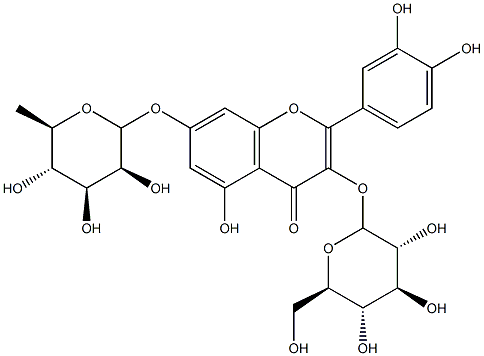18016-58-5

Product Name:
3-(β-D-Glucopyranosyloxy)-7-(α-L-rhamnopyranosyloxy)-3',4',5-trihydroxyflavone
Formula:
C27H30O16
Inquiry
SAFETY INFORMATION
| Signal word | Warning |
|---|---|
| Pictogram(s) |
 Health Hazard GHS08  Environment GHS09 |
| GHS Hazard Statements |
H361:Reproductive toxicity H410:Hazardous to the aquatic environment, long-term hazard |
| Precautionary Statement Codes |
P201:Obtain special instructions before use. P202:Do not handle until all safety precautions have been read and understood. P273:Avoid release to the environment. P280:Wear protective gloves/protective clothing/eye protection/face protection. P391:Collect spillage. Hazardous to the aquatic environment P308+P313:IF exposed or concerned: Get medical advice/attention. P405:Store locked up. |
COMPUTED DESCRIPTORS
| Molecular Weight | 610.5 g/mol |
|---|---|
| XLogP3 | -0.9 |
| Hydrogen Bond Donor Count | 10 |
| Hydrogen Bond Acceptor Count | 16 |
| Rotatable Bond Count | 6 |
| Exact Mass | 610.15338487 g/mol |
| Monoisotopic Mass | 610.15338487 g/mol |
| Topological Polar Surface Area | 266 Ų |
| Heavy Atom Count | 43 |
| Formal Charge | 0 |
| Complexity | 1020 |
| Isotope Atom Count | 0 |
| Defined Atom Stereocenter Count | 10 |
| Undefined Atom Stereocenter Count | 0 |
| Defined Bond Stereocenter Count | 0 |
| Undefined Bond Stereocenter Count | 0 |
| Covalently-Bonded Unit Count | 1 |
| Compound Is Canonicalized | Yes |
PRODUCT INTRODUCTION
description
Petiolaroside is a quercetin O-glucoside that is quercetin attached to beta-D-glucopyranosyl residue at position 3 and a alpha-L-rhamnopyranosyl residue at position 7 via glycosidic linkages. Isolated from the aerial parts of Delphinium staphisagria, it exhibits trypanocidal activity. It has a role as a trypanocidal drug and a plant metabolite. It is a quercetin O-glucoside, a trihydroxyflavone and a beta-D-glucoside. It is functionally related to an alpha-L-rhamnopyranose. It is a conjugate acid of a petiolaroside(1-).
